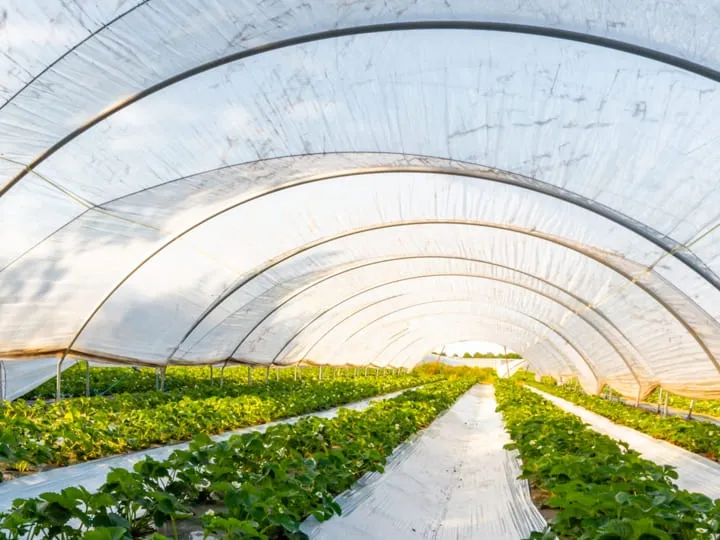Filamu za kilimo, kama vile filamu za mulch na filamu za chafu, ni vifaa visivyoweza kukosekana katika kilimo cha kisasa. Zinaboresha kwa ufanisi mazingira ya ukuaji wa mazao na kuongeza mavuno ya kilimo.
Men felaktig bortskaffande av avfall från jordbruksfilmer kan leda till allvarlig miljöförorening. Återvinning av jordbruksfilmer minskar inte bara miljöpåverkan utan underlättar också återanvändning av resurser, vilket ger betydande ekonomiska och ekologiska fördelar. Denna artikel utforskar utmaningarna och metoderna.
Nini ni Filamu ya Kilimo?
Filamu ya kilimo ni aina ya plastiki inayotumika katika kilimo na bustani ili kuboresha uzalishaji wa mazao na kulinda mimea. Imetengenezwa kutoka kwa vifaa kama polyethylene (PE) au polypropylene (PP), filamu hizi zina matumizi mbalimbali, kama vile:
- Mulchning
- Växthus
- Silageomslag
- Radhöljen

Changamoto katika Urejeleaji wa Filamu ya Kilimo
Masuala ya Uchafuzi
Filamu za kilimo mara nyingi huwekwa kwenye mashamba kwa muda mrefu, zikikusanya uchafu, viuatilifu, mbolea, na uchafuzi mwingine kwenye uso wao. Uchafuzi huu huongeza ugumu wa kusindika na kurecycle.
Kuzeeka na Uharibifu
Filamu za kilimo ambazo zimekuwa zikitumika kwa muda mrefu huwa na umri na kuwa ngumu, hasa zinapokabiliwa na mwangaza wa jua, mvua, na joto la juu. Filamu hizi zinaweza kuvunjika katika vipande, na hivyo kuleta ugumu zaidi katika ukusanyaji na usafi.
Mchanganyiko wa Vifaa
Nyenzo tofauti zinatumika katika filamu za kilimo, kama vile PE na EVA. Nyenzo mchanganyiko zinahitaji kupangwa wakati wa recyling, ambayo inaongeza ugumu na gharama ya mchakato.
Mifumo ya Urejeleaji Isiyokamilika
I många regioner har omfattande återvinningssystem för jordbruksfilmer ännu inte etablerats. Bönder kan sakna medvetenhet om återvinningspraxis, vilket leder till att avfallfilmer sprids över fälten, vilket gör centraliserad insamling mer utmanande.

Mbinu za Urejeleaji wa Filamu za Kilimo
- Mkusanyiko wa Shamba: Urejezi huanza na ukusanyaji wa filamu za taka kutoka mashambani. Wakulima wanapaswa kusafisha na kuhifadhi filamu hizo mara moja baada ya kuvuna mazao.
- Kusafisha: Filamu zilizokusanywa zinahitaji kupangwa ili kutenganisha vifaa tofauti na filamu zilizo na uchafuzi mkubwa.
- Kukata: Filamu inakatwa kwanza kupitia shredder katika vipande vidogo kwa ajili ya kusafishwa na granulation inayofuata.
- Kusanya: Mchanga, viuatilifu na viambatanisho vingine vinatolewa kwa kuosha vifaa ili kuhakikisha ubora wa usindikaji unaofuata.
- Torkning: Kisha, mashine za kuondoa unyevu au vifaa vya kukausha vinatumika kupunguza kiwango cha unyevu kujiandaa kwa pelletizing.
- Pelletizing och Återanvändning: De behandlade filmfragmenten matas in i maskin för pelletiseringdär de smälts och pressas till återvunna plastpellets. Dessa pellets kan användas för att tillverka nya jordbruksfilmer, plastledningar, förpackningsmaterial och mer, vilket fullbordar cykeln av resursåteranvändning.

Manufaa ya Urejeleaji wa Filamu za Kilimo
Manufaa ya Kiraia
Urejezi wa filamu za kilimo hupunguza taka za plastiki zilizobaki kwenye mashamba, kuzuia uchafuzi wa udongo na uharibifu wa mazingira. Pia hupunguza athari mbaya za kimazingira za kuchoma au kutupa taka za plastiki.
Thamani ya Kiuchumi
Filamu za kilimo zilizorejelewa zinaweza kutengenezwa kuwa malighafi za plastiki zenye thamani kubwa, kupunguza gharama za uzalishaji na kutoa faida za kiuchumi kwa wakulima na kampuni za kurejeleza.
Kwa muhtasari, filamu za kilimo ni ngumu kurejelewa, lakini zinaweza kurejelewa kwa ufanisi kwa kutumia njia sahihi ya granulation.






